Annual State of the NHSScotland Assets and Facilities Report for 2012
A review of asset and facilities management performance in NHSScotland, identifying the current state of the estate and facilities management, highlighting areas of best practice and areas for improvement.
Annex B
Review of Estate Assets and Performance
This Annex provides a detailed analysis of property and asset performance which supports the summarised information and analysis provided in the main body of the report. The information presented in this annex on age and tenure combines information from all 22 NHS Boards and Special NHS Boards whereas the subsequent sections on condition and performance of property assets is split between the 16 Boards with in-patient accommodation (labelled NHS Boards), ie all 14 NHS Boards and 2 Special NHS Boards namely the NHS National Waiting Times Centre (Golden Jubilee) and the State Hospitals Board for Scotland) and the 6 remaining Special NHS Boards.
Estate Age
NHSScotland occupies approximately 850,000sq.m (19% of the total) of relatively new / modern accommodation (i.e. less than 10 years old), which is an increase of 160,000sq.m since 2011 and is evidence of the significant capital investment in property assets over recent years. Investment in NHS assets, including investment in new properties, has more than trebled in cash terms in recent years, from £132.5 million in 2003/04 to £557.4 million in 2010/11 - plus £500m of additional revenue based investment. There does, however, remain substantial scope for improvement and further investment, or disposal, in the estate in order to move away from old, poor quality and functionally unsuitable properties. The following charts show the range of property ages for the NHS Boards, which indicates that 26% of the estate remains over 50 years old (a ten percentage point improvement on 2011 status).
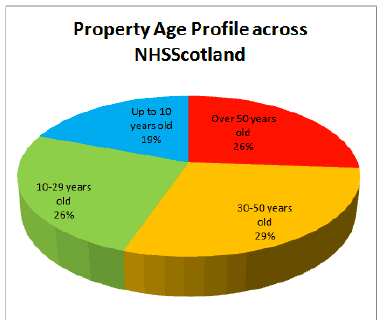
Age profile above includes all 22 NHS Boards and Special NHS Boards
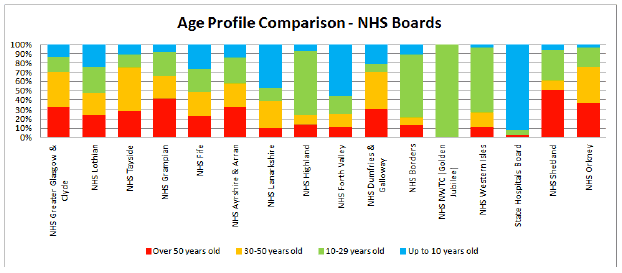
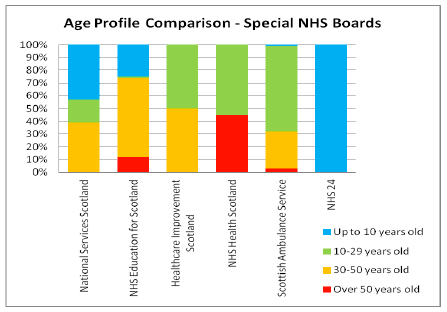
Estate Tenure
The majority of the NHSScotland estate is owned (81%) but for some NHS Boards PPP/PFI and leased property is a significant proportion of their estate, as shown in the two charts that follow.
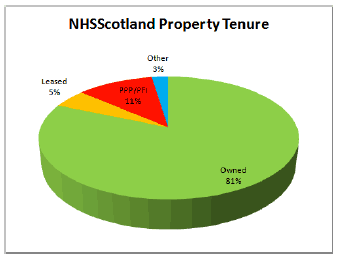
Tenure profile above includes all 22 NHS Boards and Special NHS Boards, where information is available
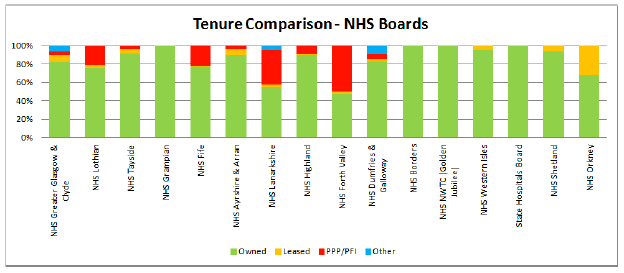
Physical condition
Analysis of the information contained within each NHS Board's Property and Asset Management Strategy (PAMS) shows that approximately 71% of the NHS Boards' estate is in good physical condition (category A or B) but, as shown in the chart below, this can vary significantly across the NHS Boards.
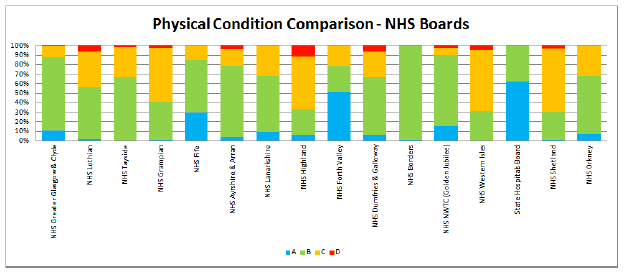
NHS Boards which have buildings assessed as category D - "unsatisfactory" have indicated that they have plans in place to either dispose or replace these buildings over the next 10 years. Hence, the overall amount of buildings in category D is expected to significantly reduce in these NHS Boards.
Backlog maintenance costs
Backlog maintenance costs arise from maintenance that has built up over a number of years and is now giving rise to poor condition and performance. These backlog maintenance costs have been identified as those required to bring the estate back to Condition Ranking B (satisfactory). It is an on-going challenge for the NHS to balance investment between that which is focussed on service improvement and development, and that which is necessary to ensure existing properties do not cause harm or undue disruption to service delivery.
An analysis of the distribution of backlog across NHS Boards is shown in the chart below. It identifies a backlog maintenance cost of £948m, which is a £62m reduction since 2011.
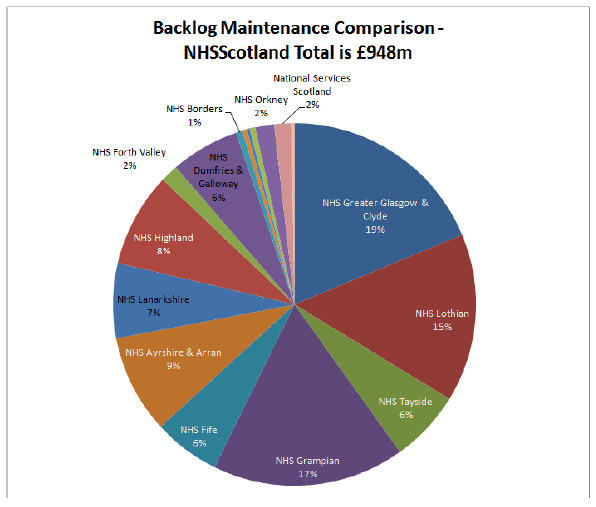
Note: the above chart includes all 22 NHS Boards and Special NHS Boards but those whose backlog is below 1% have not been separately identified for clarity of presentation reasons only.
By the very nature of a mixed use and mixed aged estate, backlog maintenance will always be present in such a large and diverse estate. The emphasis should, therefore, always be on ensuring that the level of backlog maintenance does not unduly increase the risk of building or engineering service failure to an extent that it could have a detrimental impact on each NHS Board's ability to function effectively, efficiently and safely.
NHSScotland managers are focussed on mitigation strategies for the significant backlog maintenance requirement to ensure that high and significant risk backlog is prioritised, based on the risk it poses, for investment within the finite resources made available to them. This is to be reflected in their PAMS with the analysis supported by guidance developed by Health Facilities Scotland to ensure that a common approach is taken across NHSScotland to the assessment of risk.
The two key strategies for reducing backlog maintenance are either to invest directly in the rectification of backlog or to rationalise the estate to remove those properties with high levels of backlog maintenance. For the current stock of modern buildings future backlog can be avoided by ensuring the right levels of expenditure on both operational and cyclical lifecycle maintenance.
The following chart identifies the profile of low, moderate, significant and high risk backlog for each NHS Board.
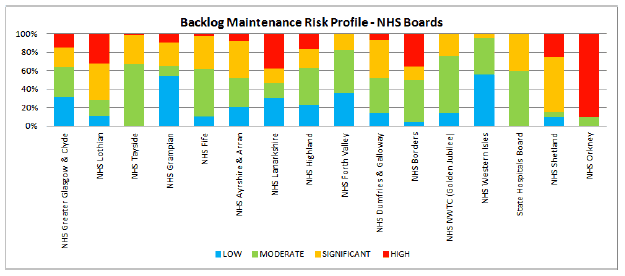
The earlier pie chart expressed the total amount of Backlog Maintenance Cost per NHS Board whereas the following chart shows the average backlog maintenance expenditure requirement per unit of total building floor area for each NHS Board.
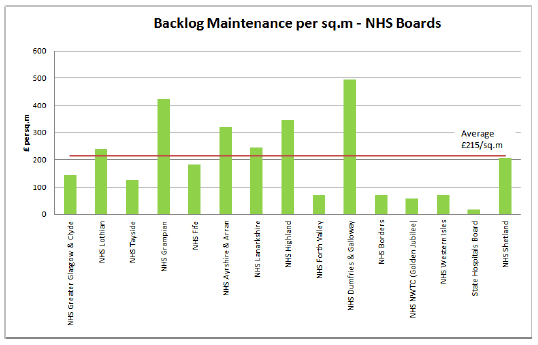
The average backlog expenditure per sq.m shown in the above chart is based on the total building floor area, whereas in practice it can be expected that the majority of backlog will be associated with the areas of poor physical condition (condition C and D). Hence, the backlog cost in a particular area that is in poor physical condition may well be considerably in excess of the average shown in the above chart.
It should also be recognised that around 12% of the current backlog maintenance expenditure requirement is in buildings which are classified as "non-clinical" and will have little impact on the patient's healthcare experience. An analysis of this by NHS Board is shown in the chart below.
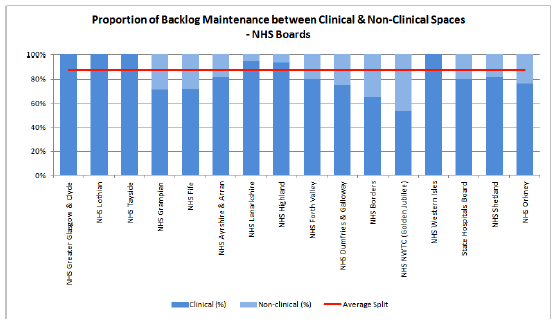
Note: not all NHS Boards have provided a split between Clinical and Non-clinical therefore the real 'Average Split' is likely to be even lower.
Approximately 45% of the total backlog maintenance expenditure identified is high or significant risk clinical space. This includes property identified for disposal.
NHS Boards are already targeting high and significant risk clinical backlog maintenance through planned maintenance and re-provision plans outlined in their PAMS. Overall, Scottish Government budgeting levels should be sufficient to reduce existing high and significant clinical backlog maintenance levels for retained property to manageable levels over the next five years.
For lower risk backlog maintenance and non clinical space, Scottish Government will work with NHS Boards to develop detailed long term plans for rationalisation and disposal of surplus, unsuitable, poor quality properties, and life cycle planned maintenance plans for retained property. These will be updated annually as part of the PAMS update and reviewed more formally through the LDP process.
Space utilisation and functional suitability
Accommodation space has a direct relationship with cost. The more space that is provided the more ownership and occupancy related costs will be incurred. The aim, therefore, is to hold only that space which is needed to support the delivery and support of effective and efficient service delivery. Under utilisation of space incurs wasted financial resources, whereas under provision of space can result in ineffective and/or inefficient working practices and poor clinical outcomes.
The following chart shows the proportion of each NHS Board's estate that is reported as being fully utilised.
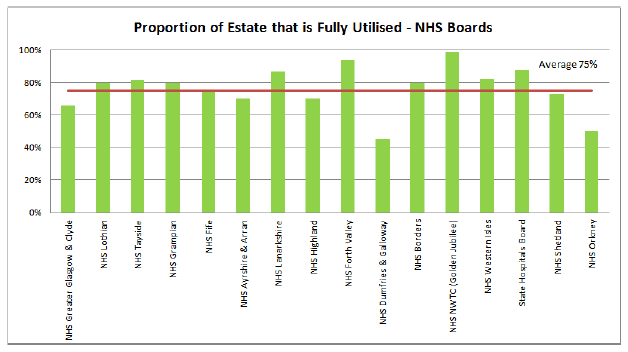
The chart below shows, in comparison with full utilisation, the proportion of each NHS Board's estate that is reported as empty, under used and overcrowded.
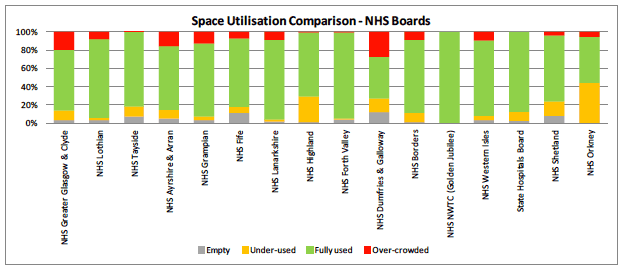
The under utilisation of accommodation across NHS Highland and NHS Orkney reflects the challenges faced from such a geographically diverse area and the need to maintain and provide critical healthcare facilities in locations with relatively low population masses
The estate also plays an important role in supporting the effective and efficient delivery of services. Poor functional suitability often results in inefficient working practices, increased staffing levels and poor clinical outcomes. Therefore, it is an important component of the organisation's overall performance. The proportion of the estate reported by NHS Boards as being functionally suitable (category A or B) is shown in the following chart.
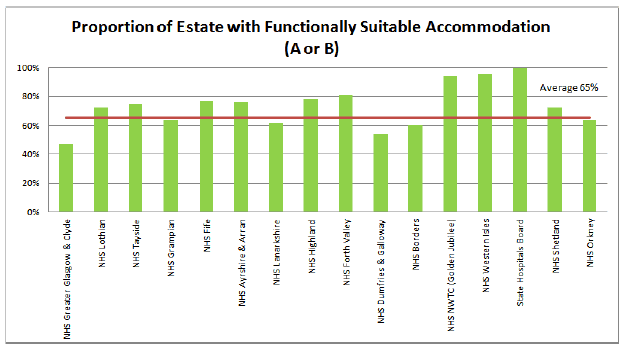
The chart above indicates a relatively good level of performance since it shows that approximately 65% of all accommodation is reported as functionally suitable (a 3 percentage point improvement on 2011 status).
NHS Boards are currently reviewing their data and performance on space utilisation and functional suitability as part of the PAMS development process.
Patient Satisfaction Survey Results relevant to Premises
Better Together is Scotland's patient experience programme, using the public's experiences of NHSScotland to improve health services. One of the key elements it is currently focussed on is the Inpatients Patient Experience Survey 2011. This asked a range of questions about people's experiences of staying overnight in a Scottish hospital and included a particular question that was relevant to the condition and performance of the hospital estate, namely "Q.13 Overall, how would you rate the hospital environment?" The following chart shows the results of the response to this question for each NHS Board:

Note: No data is available for the State Hospital Board
The results are generally positive across all NHS Boards, however, it needs to be recognised that these results are based on only one question and, therefore, should not be taken as indicating overall patient satisfaction in NHSScotland premises. An enhanced question is required to assess patient and public opinion of the estate and facilities services covering:
- Accessibility for able and disabled patients and staff
- Signposting and user friendliness of building spaces
- The internal visual, aural and thermal built environment
- Privacy and dignity
- Patient and staff opportunities to control comfort
- Access to nature and outdoors
- Facilities services - cleanliness, catering, portering etc
Performance Improvement of Property Assets
The following chart provides a comparative overview of performance improvement in property assets between 2011 and 2012:
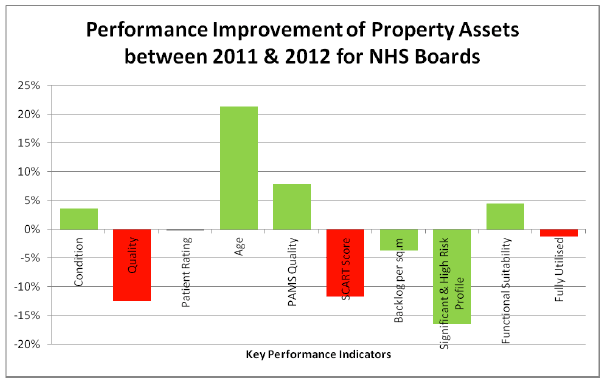
Note: green bars above the horizontal indicate a positive improvement whereas a red bar below the horizontal indicates a performance reduction
The above chart highlights performance improvement in several key indicators; such as property condition, age, quality of PAMS, backlog maintenance and functional suitability. The main focus for NHS Boards over this year has been estate rationalisation and reduction in backlog maintenance and these positive results reflect the good progress made on these initiatives. 2011-12 has also seen a significant re-appraisal of the condition and performance of property assets, including verification of existing data. This has also had an impact on the above results and can explain some of the further variation in performance results between 2011 and 2012 (particularly the reduced performance scores for Quality, SCART score and Fully Utilised).
Condition and Performance of Special NHS Boards' Property Assets
The information presented in this section of the annex relates to the following 6 Special NHS Boards:
- NHS National Services Scotland.
- NHS Education for Scotland.
- Healthcare Improvement Scotland.
- NHS Health Scotland.
- Scottish Ambulance Service.
- NHS 24.
Together, their combined estate accounts for approximately 145,000 sq.m of accommodation, as shown in the chart that follows:
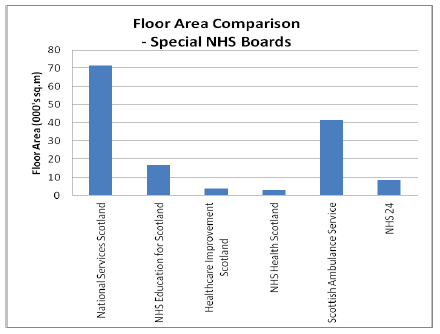
Condition and Performance
The physical condition of these properties is slightly poorer than that of the NHS Boards, with only 58% in good physical condition (category A or B), compared with 71% for the NHS Boards, as shown in the chart below:
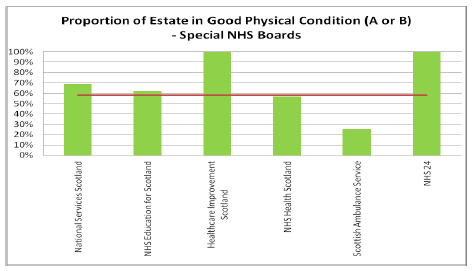
The functional suitability of these properties is similar to that of the NHS Boards, with 64% being functionally suitable, as shown in the chart below:
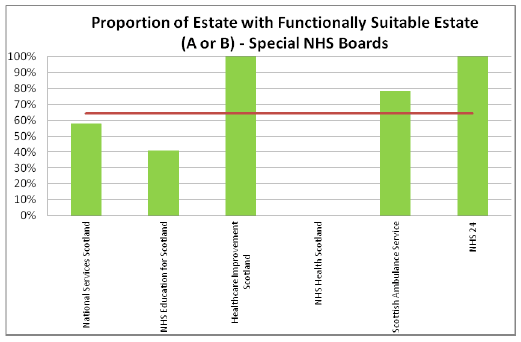
Note: NHS Health Scotland report that 100% of their estate is in Category C (unsuitable) for Functional Suitability
The space utilisation of these properties is similar to that of the NHS Boards, with 72% of accommodation being fully utilised, as shown in the chart below:
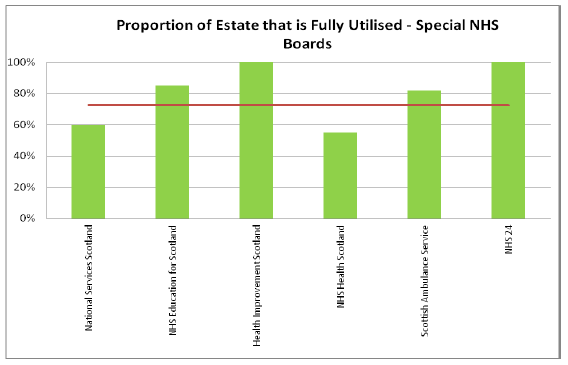
Special NHS Boards - Office Accommodation
Any examination of the NHSScotland estate needs to recognise that much of the property occupied by the Special NHS Boards is office accommodation which is quite different in form and functionality from the majority of the accommodation occupied by the NHS Boards. An example of this is the tenure status of occupied accommodation where there is much greater use of leased office accommodation in the Special NHS Boards.
All Special NHS Boards recognise the importance of rationalising their estate to maximise efficiency and reduce the number of Special NHS Board properties. Special NHS Boards are currently focusing on maximising the utilisation of Meridian Court in Glasgow and Gyle Square in Edinburgh which will have a significant impact on the overall amount of leased properties held.
Whilst the Special NHS Boards are an essential and integral part of NHSScotland, their office estate has more in common with the wider civil and government estate that is occupied by government departments and agencies. This very large public sector office estate also has much in common with the extensive office estate that is occupied by a wide range of private sector bodies and organisations.
Over recent years the Special NHS Boards have made significant progress on introducing new ways of working, flexible working and workplace redesign. In particular, NHS National Services Scotland (NSS) has done extensive measurement of space efficiency and costs across its own large and diverse office estate as part of implementing its Property Strategy which is focused on:
- Providing well designed and efficient space which is flexible towards embracing changing working practices and new technology
- Maximising the opportunity for staff to develop and deploy their knowledge, skills and personal qualities creatively to add value to the business and services
- Achieving synergies from shared use of accommodation and support services.
Case Study 9 in this report describes an exemplary office refurbishment project recently completed by NHS National Services Scotland.
An NHSScotland National Office Performance Framework has now been developed which will enable the performance of the Special NHS Board's office accommodation to be measured and monitored on an annual basis as part of this report. It is similar to the framework used for the NHS Boards but KPIs have been developed which are relevant and specific to office accommodation and facilities services. This framework will be populated and presented in the 2013 State of Assets and Facilities Report.
It should also be noted that within their total estate the NHS Boards also have significant amounts of office accommodation which benefit from similar best practice arrangements as those in Special NHS Boards. Work is in hand with a number of NHS Boards to further review their office accommodation in line with the UK Government standard benchmarks for office accommodation.
Contact
Email: James H White
There is a problem
Thanks for your feedback